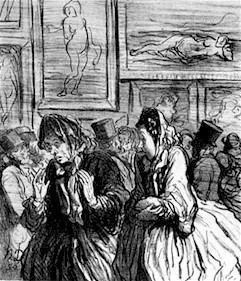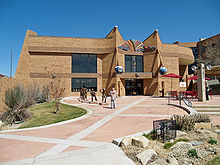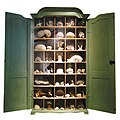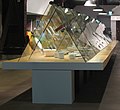The Museums Portal
A museum (/mjuːˈziːəm/ mew-ZEE-əm) is an institution dedicated to displaying and/or preserving culturally significant objects. Many museums have exhibitions of these objects on public display, and some have private collections that are used by researchers and specialists. Compared to a library, a museum hosts a much wider range of objects and usually focus around a specific theme such as the arts, science, natural history, local history, and other topics. Public museums that host exhibitions and interactive demonstrations are often considered to be tourist attractions, and many museums attract large numbers of visitors from outside their host country, with the most visited museums in the world regularly attracting millions of visitors annually.
Since the establishment of the earliest known museum in ancient times, museums have been associated with academia and the preservation of rare items. Museums originated as private collections of interesting items, and not until much later did the emphasis on educating the public take root. (Full article...)
Selected museum
The Palais Rohan (Rohan Palace) in Strasbourg is the former residence of the prince-bishops and cardinals of the House of Rohan, an ancient French noble family originally from Brittany. It is a major architectural, historical, and cultural landmark in the city. It was built next to Strasbourg Cathedral in the 1730s, from designs by Robert de Cotte, and is considered a masterpiece of French Baroque architecture. Since its completion in 1742, the palace has hosted a number of French monarchs such as Louis XV, Marie Antoinette, Napoleon and Joséphine, and Charles X.
Reflecting the history of Strasbourg and of France, the palace has been owned successively by the nobility, the municipality, the monarchy, the state, the university, and the municipality again. Its architectural conception and its iconography were intended to indicate the return of Roman Catholicism to the city, which had been dominated by Protestantism for the previous two centuries. Thus the prelate's apartments face the cathedral, to the north, and many of the statues, reliefs and paintings reflect Catholic dogma.
Since the end of the 19th century the palace has been home to three of Strasbourg's most important museums: the Archaeological Museum (Musée archéologique, basement), the Museum of Decorative Arts (Musée des arts décoratifs, ground floor) and the Museum of Fine Arts (Musée des beaux-arts, first and second floor). The municipal art gallery, Galerie Robert Heitz, in a lateral wing of the palace, is used for temporary exhibitions. The Palais Rohan has been listed since 1920 as a Monument historique by the French Ministry of Culture. (Full article...)
Selected interior image
Selected general article

An art exhibition is traditionally the space in which art objects (in the most general sense) meet an audience. The exhibit is universally understood to be for some temporary period unless, as is occasionally true, it is stated to be a "permanent exhibition". In American English, they may be called "exhibit", "exposition" (the French word) or "show". In UK English, they are always called "exhibitions" or "shows", and an individual item in the show is an "exhibit".
Such expositions may present pictures, drawings, video, sound, installation, performance, interactive art, new media art or sculptures by individual artists, groups of artists or collections of a specific form of art. (Full article...)
Did you know...
- ... that Lamia Al-Gailani Werr helped rebuild the Iraq Museum after it was looted in the 2003 American-led invasion of Iraq?
- ... that landscape architect Harriet Pattison collaborated with her lover Louis Kahn on the design of Four Freedoms Park and the grounds of the Kimbell Art Museum?
- ... that Sheikh Mujibur Rahman proclaimed the independence of Bangladesh from his residence in Dhaka before his arrest by the Pakistan Army?
- ... that the New Zealand stonefly Stenoperla prasina was the five millionth specimen digitised by the Natural History Museum in London?
- ... that Gracie Mansion became New York City's mayoral residence after serving as a public toilet and a museum?
- ... that Saint Rose Catholic Church was moved from the ghost town of Fleetwood, Oregon, to the Fort Rock Valley Historical Homestead Museum in 1988?
Get involved
For editor resources and to collaborate with other editors on improving Wikipedia's Museums-related articles, see WikiProject Museums.
Selected exterior image
Selected type of museum

Children's museums are institutions that provide exhibits and programs to stimulate informal learning experiences for children. In contrast with traditional museums that typically have a hands-off policy regarding exhibits, children's museums feature interactive exhibits that are designed to be manipulated by children. The theory behind such exhibits is that activity can be as educational as instruction, especially in early childhood. Most children's museums are nonprofit organizations, and many are run by volunteers or by very small professional staffs.
International professional organizations of children's museums include the Association of Children's Museums (ACM), which was formed in 1962 as the American Association of Youth Museums (AAYM) and in 2007 counted 341 member institutions in 23 countries, and The Hands On! Europe Association of Children's Museum (HO!E), established in 1994, with member institutions in 34 countries as of 2007. Many museums that are members of ACM offer reciprocal memberships, allowing members of one museum to visit all the others for free or for a discounted fee. (Full article...)
Subcategories
Subtopics
Lists
- Museums
- Most visited museums (by region)
- Art museums: most visited, largest
Types
- Art museum
- Agricultural museum
- Archaeology museum
- Architecture museum
- Artillery museum
- Aviation museum
- Biographical museum
- Cabinet of curiosities
- Ceramics museum
- Children's museum
- Community museum
- Computer museum
- Design museum
- Dime museum
- Ecomuseum
- Economuseum
- Ethnographic village
- Farm museum
- Fashion museum
- Folk museum
- Food museum
- Green museum
- Hair museum
- Hall of Memory
- Heritage centre
- Historic house museum
- Human rights museum
- Imaginarium
- Interpretation centre
- Jewish museum
- Lapidarium
- Lighthouse museum
- Living museum
- Local museum
- Maritime museum
- Migration museum
- Mobile museum
- Museum ship
- National history museum
- Natural history museum
- Open-air museum
- Palace museum
- Postal museum
- Prefectural museum
- Print room
- Private museum
- Regimental museum
- Schatzkammer
- Science fiction libraries and museums
- Science museum
- Sex museum
- Sculpture garden
- Technology museum
- Textile museum
- Torture museum
- Toy museum
- Transport museum (list)
- University museum
- Virtual museum
- Wax museum
- Writer's home
Related
Associated Wikimedia
The following Wikimedia Foundation sister projects provide more on this subject:
-
 Commons
Commons
Free media repository -
 Wikibooks
Wikibooks
Free textbooks and manuals -
 Wikidata
Wikidata
Free knowledge base -
 Wikinews
Wikinews
Free-content news -
 Wikiquote
Wikiquote
Collection of quotations -
 Wikisource
Wikisource
Free-content library -
 Wikiversity
Wikiversity
Free learning tools -
 Wiktionary
Wiktionary
Dictionary and thesaurus
-

-

-

-

-
Random portal
Purge server cache


























































